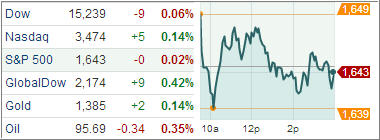Major market index ETFs had an up and down Monday as they moved above and below the flat line in choppy action, finishing mixed and nearly flat, as a plethora of divergent global economic data and an empty domestic docket met an upgrade of the U.S.’ credit rating outlook by Standard & Poor’s.
The market did not provide a lot of trading excitement today. The Dow Jones Industrial Average declined 10 points (0.1%) to 15,238, the S&P 500 Index lost nearly a point to 1,643, and the Nasdaq Composite gained 5 points (0.1%) to 3,474.
There was some excitement when it was announced before the open that Standard & Poor’s raised its U.S. outlook to Stable from Negative, citing a lessening of downside risks to its AA+ rating for U.S. sovereign debt. The reaction to the revision of the U.S. sovereign credit outlook gave stocks only a short-lived lift, as a concurrent rise in long-term interest rates seemed to limit the stock market’s enthusiasm for the outlook change. The yield on the 10-year note moved up to 2.23%, or roughly six basis points higher than where it settled on Friday. There were no major U.S. economic reports scheduled to be released today.
Overseas, China’s exports rose at a much smaller rate than expected, while imports unexpectedly fell, resulting in a larger-than-expected widening of the country’s trade surplus. Additionally, producer prices dropped sharply year-over-year, and consumer prices came in cooler than expected. Finally, China’s industrial production and retail sales both rose in line with expectations. On the other hand, Japan’s 1Q GDP was unexpectedly revised higher, while French industrial production came in higher than forecasts, but Italy’s GDP and industrial production data fell short of expectations.
St. Louis Fed President Bullard addressed economic conditions in a speech today on the global economy. Mr. Bullard suggested the low rate of inflation could be justification for the Fed to maintain its aggressive asset buying over a longer time frame and then added that an improved labor market could mean the Fed might slow the pace of its asset purchases. Against the backdrop of the daily grappling with the Fed’s exit strategy, this week’s U.S. economic calendar is poised to keep the debate rolling.
Today’s lack of conviction fed into our Trend Tracking Indexes (TTIs), which did not budge much from Friday’s close. The Domestic TTI ended at +2.97% while the International TTI settled at +6.25%.
Contact Ulli
